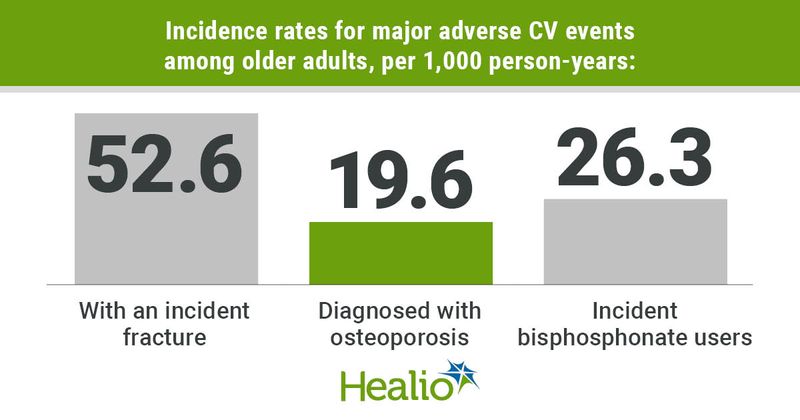CVD and fracture risk factors may predict CV risk for older adults with osteoporosis
Prediction models incorporating both cardiovascular disease and fracture risk factors may be able to predict the risk for major adverse CV events in adults with osteoporosis, according to study data.
“In this study, we evaluated the incidence of major adverse CV events though a composite outcome ... and assessed risk factors of CVD to predict this outcome at 1 year in three different cohorts,” Daniel Prieto-Alhambra, MD, PhD, professor of pharmaco- and device epidemiology research at the Centre for Statistics in Medicine in the Nuffield Department of Orthopaedics, Rheumatology and Musculoskeletal Sciences, Nuffield Orthopaedic Centre at the University of Oxford in the U.K., and colleagues wrote in a study published in The Journal of Bone and Mineral Research. “The incident fragility fracture cohort can be used for a secondary fracture prevention program, the starting oral bisphosphonates cohort has the potential to be used in primary prevention since it approximates patients newly diagnosed and treated for osteoporosis, while the recently diagnosed with osteoporosis cohort can be used as a general screening in primary care.”

Researchers obtained data from the Clinical Practice Research Datalink (CPRD) GOLD database in the U.K. of adults aged at least 50 years at high or imminent fracture risk from 1995 to January 2017. Data were linked to Hospital Episode Statistics Admitted Patient Care data, the Office for National Statistics mortality records and the Index of Multiple Deprivation dataset. The study population was divided into a group of 65,295 adults with an incident diagnosis of osteoporosis (86.8% women; mean age, 73.05 years), a group of 67,065 adults with a first incident fracture at an osteoporotic site (76.7% women; mean age, 79.52 years) and a group of 145,959 incident users of oral bisphosphonates without bisphosphonate use the prior year (79.8% women; mean age, 74.35 years). Participants were followed from the time of diagnosis, incident fracture or start of bisphosphonates for a maximum of 2 years. The main outcome was 1-year occurrence of major CV adverse events, which was defined as the first occurrence of stroke, myocardial infarction or death due to CVD.
At 1 year, the incident fracture group had the highest major adverse CV event (MACE) incidence rate at 52.6 per 1,000 person-years, the oral bisphosphonate group had an incidence rate of 26.3 per 1,000 person-years and the osteoporosis cohort had the lowest incidence rate at 19.6 per 1,000 person-years. Adults experiencing MACE were older, had more comorbidities and a higher prevalence of drug use.
Predictive models using general, CVD and fracture risk factors selected by Lasso regression had an area under the curve of greater than 70% for all three cohorts. These models outperformed models using QRISK factors. Models predicting MACE in the osteoporosis and oral bisphosphonate outcomes had higher discrimination values compared with models predicting stroke or MI, whereas discrimination values within the incident facture cohort were higher for models predicting stroke and MI compared with models predicting MACE.
“The resulting algorithms include risk factors specific to the study population as well as more generic features that can be found easily in primary care data,” the researchers wrote. “Further work will focus on validating these models in external cohorts.”
